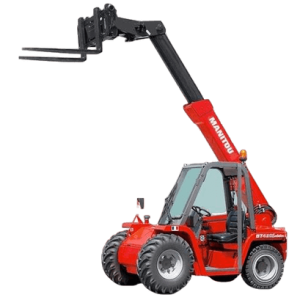What is a Telehandler?
A Telehandler, also known as a telescopic handler, is a machine commonly used in agriculture and industry. Similar to a forklift but more akin to a crane, it’s distinguished by a single telescopic or articulating boom that can extend forwards and upwards from the vehicle, allowing it to reach areas inaccessible to a traditional forklift.
Telehandlers can work with a variety of attachments, including buckets, pallet forks, muck grabbers, and lift tables, enhancing their utility in different situations. This versatility, combined with their ability to reach heights and distances, makes them invaluable in construction sites, warehouses, farms, and other settings where materials need to be lifted, moved, or placed.
Some telehandlers even have rotating capabilities, which enable them to unload, store, distribute, and pick up materials on any type of ground, further increasing their adaptability in various work conditions.
As for performance, modern telehandlers are designed to deliver maximum output with low fuel consumption due to the adaptive control of pulling and lifting power. Some manufacturers like JCB even offer electric models that produce zero emissions and less noise without compromising performance.

The Key Features of A Telehandler
- Telescopic Boom: The defining feature of a telehandler is its extendable boom, which can reach heights that a traditional forklift cannot. This boom can extend forwards and upwards to place loads in high or hard-to-reach places.
- Load Capacity: Telehandlers can lift considerably heavy loads, often ranging from 3,000 up to 20,000 pounds depending on the model and configuration.
- Versatility: Telehandlers can be fitted with various attachments like buckets, pallet forks, muck grabbers, or lift tables, making them suitable for a range of tasks.
- Four-Wheel Drive and Steering: Most telehandlers have four-wheel drive for excellent off-road capability and can have different steering modes (front-wheel, all-wheel, crab steering) for improved manoeuvrability.
- Operator Cabin: The operator cab is equipped with controls to operate the boom and attachments. It usually offers good visibility, comfort features, and safety measures like rollover protection.
- Stabilizer Legs: Many telehandlers have extendable stabilizer legs or outriggers that provide additional stability when lifting heavy loads or reaching full extension.
- Safety Features: Telehandlers often include load management systems to prevent overloading and tipping, as well as other safety measures like backup alarms, mirrors for improved visibility, and safety belts.
- Compact Size: Despite their powerful capabilities, telehandlers are relatively compact, which allows them to operate in tighter spaces than a crane.
- Power Source: Telehandlers are typically diesel-powered, but electric models are becoming more common for indoor use or in environments where emissions need to be minimized.
- High Ground Clearance: Telehandlers often have high ground clearance, which makes them ideal for construction sites and other rough terrain.